Sapphire Pulse Radeon RX 5700 review: A stunning value supercharged by clever software tricks - mccrayfourgaver99

At a Glance
Expert's Rating
Pros
- Excellent gaming performance
- Cooler and quieter than citation designs
- Trixx Boost software uses upscaling for great FPS gains
- Dual-BIOS for performance operating room acoustic sharpen
- PCIe 4.0 compatible
Cons
- Plastic shroud
- No consecrated ray trace hardware
- Trixx Boost feature not forthcoming at found
Our Verdict
The Radeon RX 5700 already provided sensational value for 1440p gamers. Sapphire's custom Pulse RX 5700 builds atop that for sporting $9 more, and pushes performance even further with its excellent Trixx Advance upscaling.
Outdo Prices Today

$359
AMD promised that custom Radeon RX 5700 graphics card game would arrive in mid-August, and as of Monday, they'Re here. The wait was worth IT.
Sapphire's kicking things off with its budget-friendly Pulse lineup. Like-minded its predecessors, it offers some precise features and solid cooler designs at prices that won't break the trust. Just one of Sapphire's most intriguing additions has naught to do with hardware. We're highly affected past the new performance-enhancing, resolution-tweaking "Trixx Boost" feature film in the company's Trixx software package suite, which leverages AMD's Radeon Image Sharpening technology to great effect for everyday gamers.
Some the $359 Sapphire Pulse Radeon RX 5700 and $409 Sapphire Pulse RX 5700 XT go on sales event today, with each overlooking a mere nine dollar price premium over AMD's Radeon RX 5700 series quotation models. Straightaway that's some killer value. This is no paper launch either; Sapphire representatives told ME that the cards will comprise "along ledge in good quantity" on Aug 12.
We received the to a greater extent affordable Sapphire Pulse rate RX 5700 for examination, and to give off the ending, it delivers a whole allot of smasher for your dollar bill. This is a superb 1440p gaming alternative. Let's take it for a whirl!
Sapphire Pulse RX 5700: Specs and features
The Heart rate is powered by the same core GPU establish in AMD's reference models, See to it KO'd our avant-garde Radeon RX 5700 and 5700 XT review for a deep nosedive happening its technical details, like ROP and transistor counts, and an overview of AMD's new RDNA graphics architecture.
Here's a much practical breakdown of the Sapphire Pulse RX 5700 and 5700 Crosstalk's capabilities for gamers:
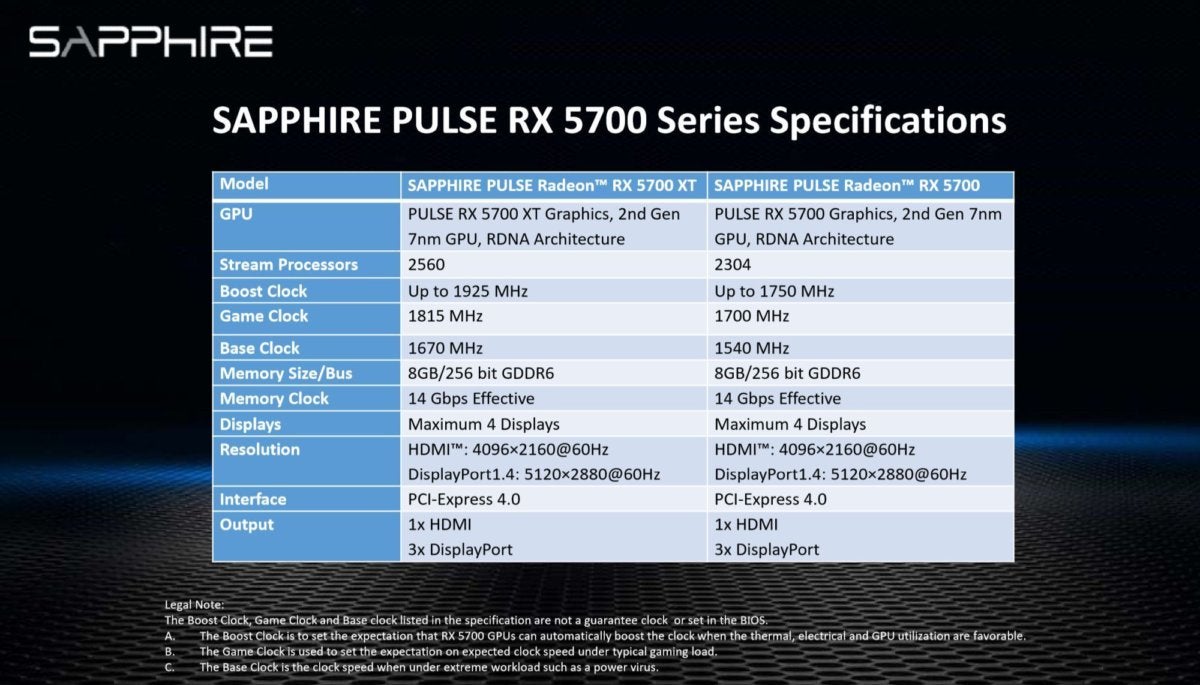 Sapphire
Sapphire The bill of fare includes niceties new to the Radeon RX 5700 series, including 8GB of blazing-fast GDDR6 memory over a 256-bit bus, and cutting-edge PCIe 4.0 functionality if you're running ace of AMD's excellent Ryzen 3000 processors in an X570 motherboard. PCIe 4.0 speeds are better suited to creative workloads, though.
For gamers, Chromatic bolstered the Pulse cards with mild overclocks. (The company's no doubt delivery beefier tunings for more capable Nitro-branded versions of the RX 5700 in the future.) The Pulse RX 5700 offers Base and Mettlesome Time speeds of 1,540MHz and 1,700MHz, severally, compared to the slower 1,465MHz and 1,625MHz reference point speeds.
"Game clock" is freshly AMD language for the expected clock speeds you'll take in in gaming workloads, and equivalent to Nvidia's Boost time ratings. AMD's Boost clock speeds are the maximum peak speed achievable in brief bursts, typically in not-gaming scenarios. We confirmed Sapphire's card so hovered between 1,690MHz and 1,700MHz in gaming benchmarks.
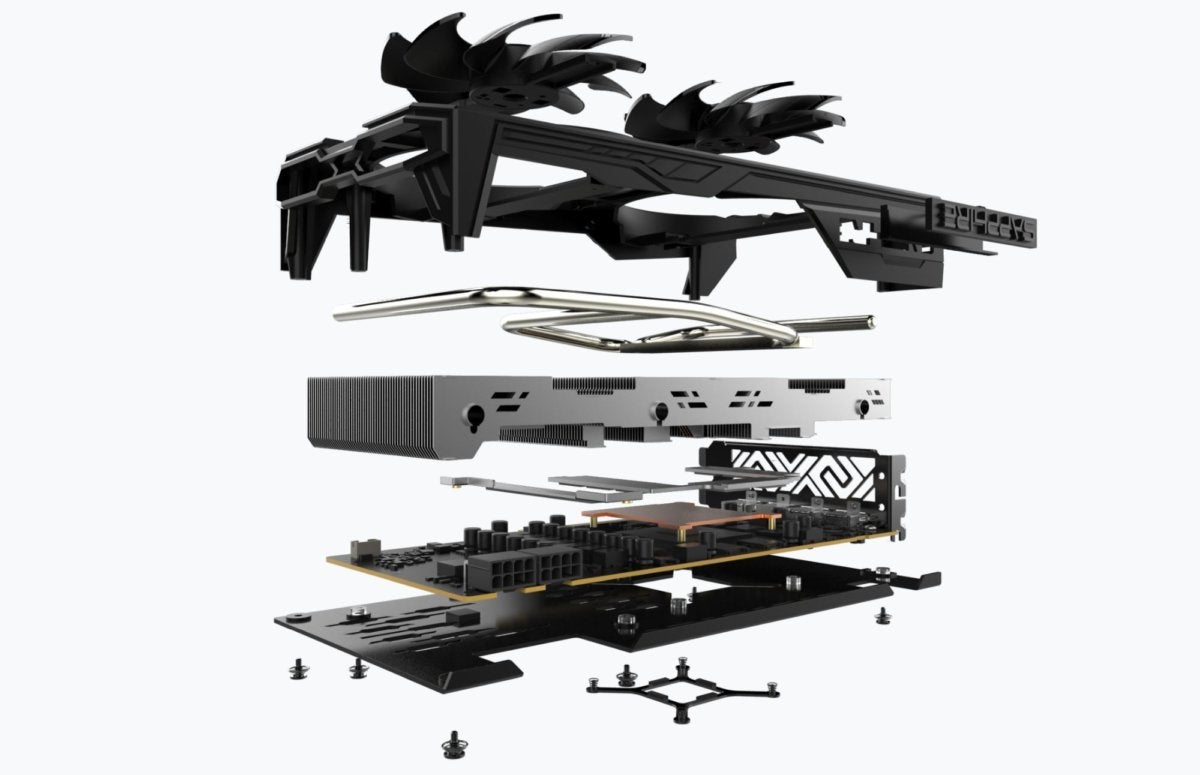 Azure
Azure A shoo-in render of the Sapphire Heartbeat RX 5700 cooler.
The literal value lays in the add-in design. While the first wave of Radeon RX 5700 offerings all stuck to the reference model's tedious (simply immensely improved) blower-style temperature reduction, which uses a single fan to expel hot air of the back of your system, the Sapphire Pulse RX 5700 deploys a Sir Thomas More coarse duple-axial rooter design. Dual-axial designs run cooler and quieter than blower-manner options, but dump the hot air back into your system, relying on your case fans to circulate the hot up out.
Sapphire well-found the Pulse Radeon RX 5700 with bigger-than-usual 95mm fans atop a tall heatsink. Larger fans can run quieter than standard-sized ones, but they push the width of the card about an inch past the norm. Make up mindful of that if you're hoping to jam the Pulse into a space-affected mini-ITX case. IT shouldn't be an publication in true tower cases.
 Brad Chacos/IDG
Brad Chacos/IDG There's a track-out in the backplate for the dual-BIOS switch.
The Sapphire Pulse makes much less disturbance than RX 5700 reference cards. You bathroom reduce the volume even further, though, away activating the card's secondary "Silent" profile via a physical dual-BIOS substitution happening the outer edge of the card. Doing so makes the card run much quieter but drops the GPU speeds to 1,465MHz Base / 1,625MHz Game clocks. The (identical) slight drop in performance might be Charles Frederick Worth the acoustic improvement to your ears, though.
The focus on thermals continues under the goon. The Sapphire Pulsate RX 5700 packs dedicated VRM and storage cooling to keep temperatures low, with a conductivity pad over the VRMs transferring heat to the graphics carte's unabridged gilded backplate—a nice extra to find on a card that costs just $9 more than reference point designs. The 12-layer PCB includes 7+1+2 phase digital power and fuse protection against power surges, while the plastic shroud includes the Sapphire epithet in enthusiastic crimson letters. A metal-looking Beaver State firmer plastic shroud would live welcome, but again: Chromatic's only charging $9 more for all these extras, and the card looks just fine in your case.
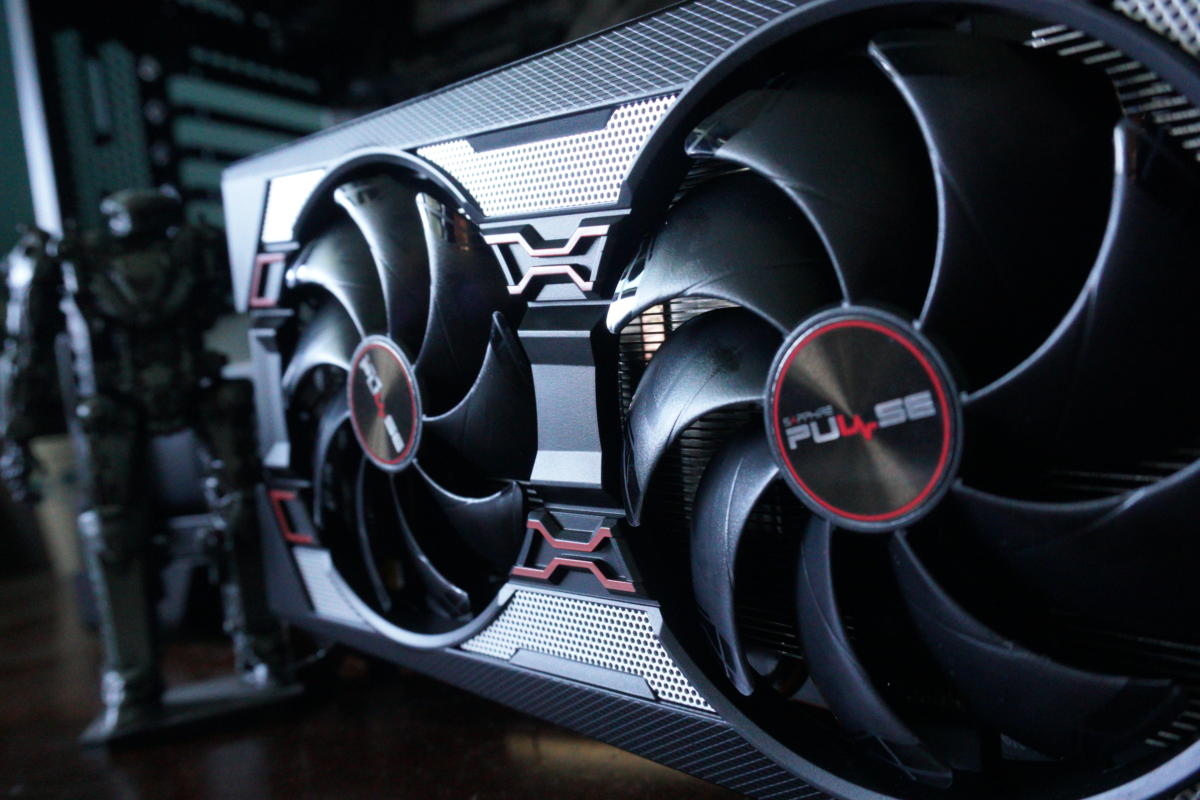 Brad Chacos/IDG
Brad Chacos/IDG Connection-sapient, the Sapphire Pulsation RX 5700 packs a one-person HDMI port and a triple of DisplayPorts.
Soon, Sapphire will release an updated version of its Trixx overclocking and monitoring software that includes a new feature dubbed Trixx Encouragement. Boost creates custom display resolutions somewhat under the standard monitor lizard resolution for a noticeable performance boost, and then uses AMD's inexperienced Radeon Image Sharpening to minimize the visual bear upon. It's great—but we'll dive into that in a separate section later on the standard performance benchmarks.
Next page: Our testing setup, gaming benchmarks begin
Our test system
Our sacred graphics card test system is packed with some of the fastest complementary components available, to put any potential difference performance bottlenecks squarely connected the GPU. All but of the computer hardware was provided by the manufacturers, merely we purchased the cooler and storage ourselves.
- Intel Pith i7-8700K processor ($350 happening Amazon)
- EVGA CLC 240 closed-loop clear cooler ($120 on Amazon)
- Asus Maximus X Hero motherboard ($395 on Amazon)
- 64GB HyperX Predator RGB DDR4/2933 ($420 on Virago)
- EVGA 1200W SuperNova P2 power supply ($230 on Amazon)
- Corsair Crystal 570X RGB display case, with front and top panels remote and an extra tail end devotee installed for developed air flow ($130 on Amazon)
- 2x 500GB Samsung 860 EVO SSDs ($78 from each one connected Amazon River)
We'rhenium comparison the $359 Sapphire Pulsate RX 5700 against AMD's $350 Radeon RX 5700 and $400 Radeon RX 5700 XT reference models, too as Nvidia's $350 GeForce RTX 2060, $400 GeForce RTX 2060 Topnotch, and $500 GeForce RTX 2070 Super. If you want to see how AMD's newborn GPUs stack improving against a wider range of cards, be sure to check out our original Radeon RX 5700 series review. (Pamperer: They'Ra great options, and the $350 Radeon RX 5700 North Korean won an Editors' Prize award.)
All prices cited are launch MSRP; you can sometimes find these cards cheaper on the streets.
Each game is tested using its in-lame benchmark at the highest potential graphics presets, with VSync, frame value caps, and all GPU seller-specific technologies—same AMD TressFX, Nvidia GameWorks options, and FreeSync/G-Sync—disabled, and temporal opposed-aliasing (TAA) enabled to push these high-end cards to their limits. If anything differs from that, we'll cite it. We escape to each one benchmark at least threefold and list the average result for each mental test.
Because the Sapphire Pulse is just a slightly quicker Radeon RX 5700 at its core, we'rhenium going to skip our usual commentary after each bench mark and let the examination speak up for itself, aside from in the Trixx Boost and thermals sections.
Gaming performance benchmarks
Division 2
Let's bulge with the latest games. The Division 2 is one of the Sunday-go-to-meeting looter-shooters ever created, and the luscious visuals generated by Ubisoft's Snowdrop engine make it even easier to get unredeemed in postal service-apocalyptic Washington D.C. The built-in benchmark cycles through quartet "zones" to test an array of environments, and we test with the DirectX 12 renderer enabled. It provides better carrying out crosswise-the-board than the DX11 renderer, but requires Windows 10.
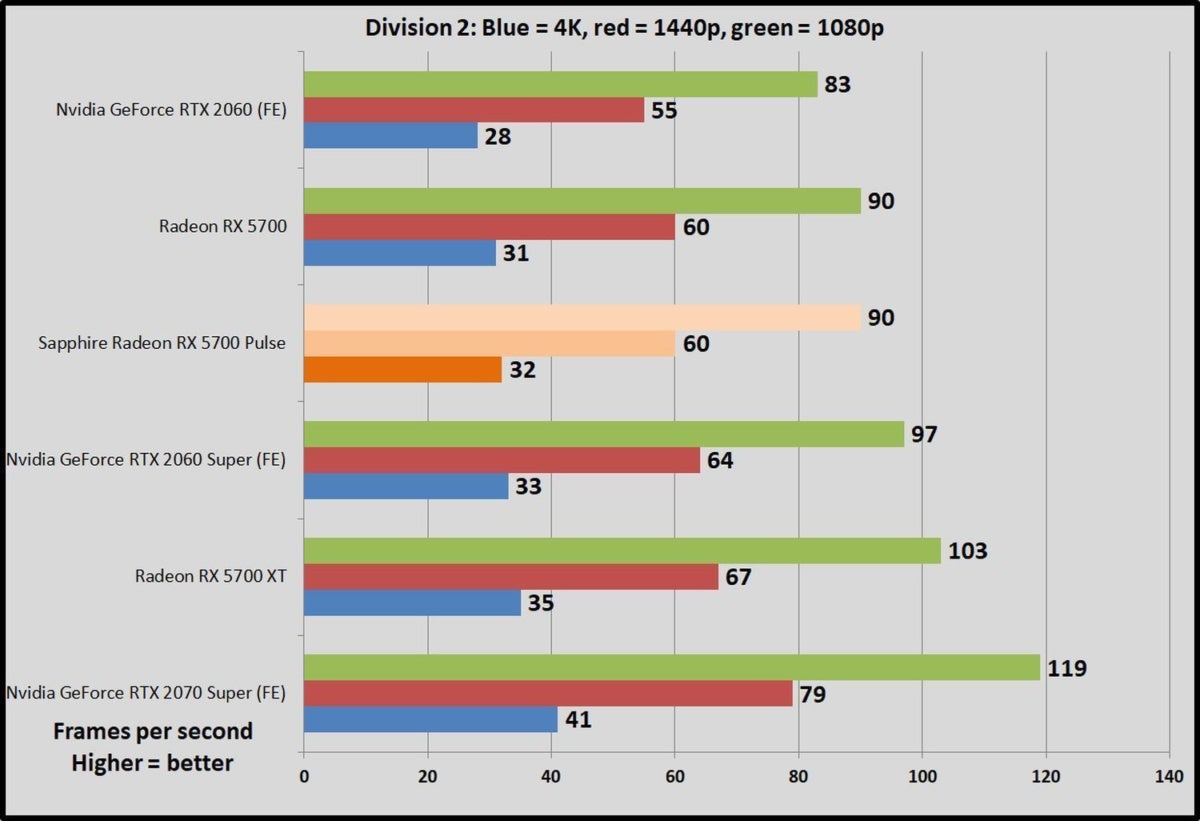 Brad Chacos/IDG
Brad Chacos/IDG ALIR Cry: New Dayspring
Another Ubisoft title, Far Cry: New Dawn drags Far Cry 5's wonderful gameplay into a post-apocalyptic future of its own, though this imaginativeness is a lot more bombastic—and pink—than The Division 2's bleak setting. The game runs on the latest version of the long-running Dunia engine, and it's slightly more strenuous than Long Cry 5's inbuilt benchmark.
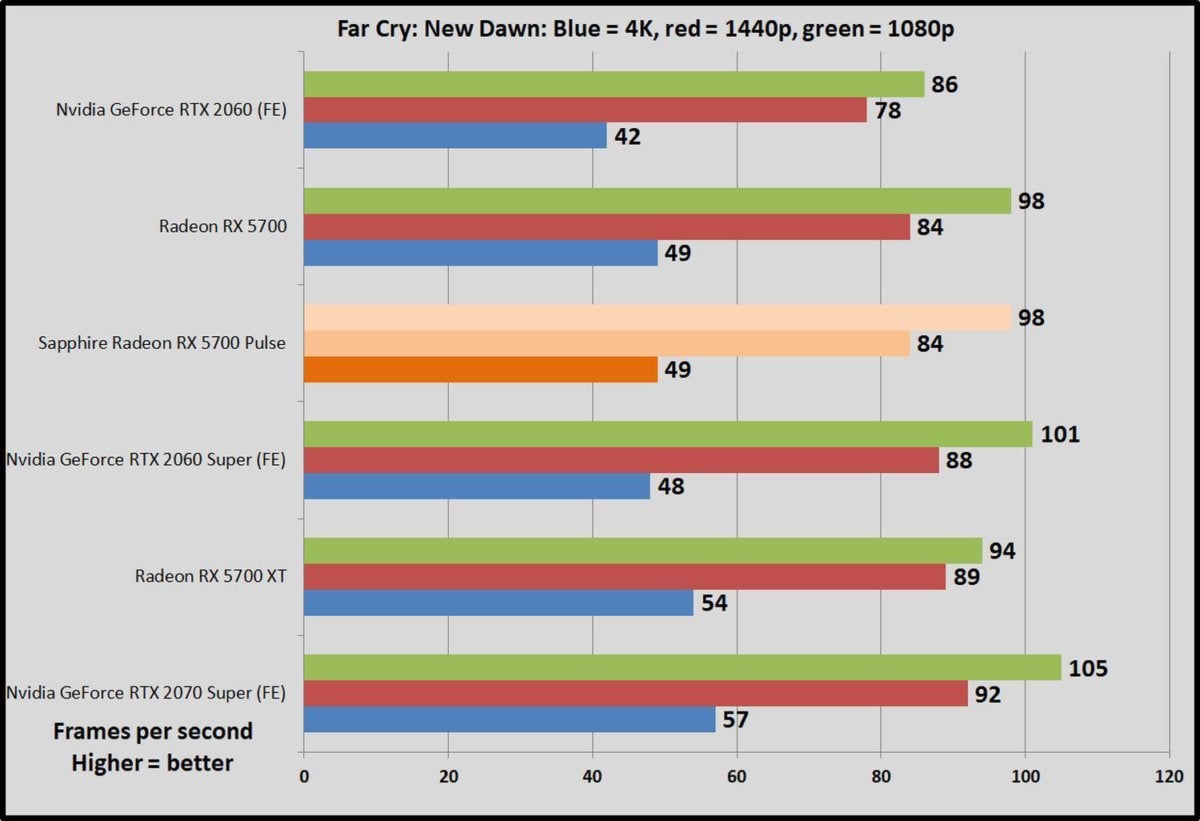 Brad Chacos/IDG
Brad Chacos/IDG Strange Brigade
Strange Brigade ($50 on Humble) is a cooperative third-person shooter where a team of adventurers blasts through hordes of mythological enemies. It's a technological showcase, built approximately the next-gen Vulkan and DirectX 12 technologies and infused with features like HDR support and the ability to toggle anachronistic work out off and on. IT uses Rebellion's custom Azure engine. We test the DX12 renderer with async compute disconnected.
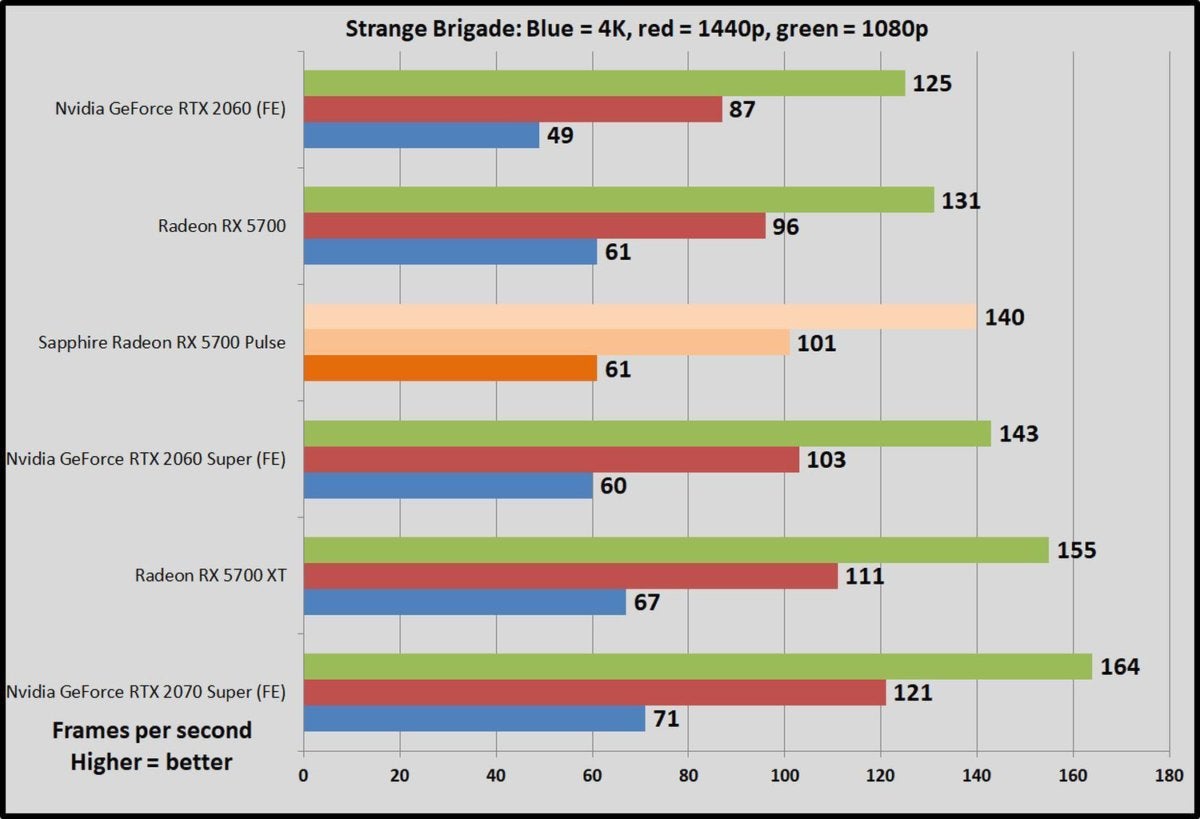 Brad Chacos/IDG
Brad Chacos/IDG Incoming page: Gaming benchmarks keep going
Shadow of the Grave Raider
Shadow of the Tomb Raider ($60 on Humble) concludes the reboot trilogy, and it's perfectlygorgeous. Square Enix optimized this game for DX12, and recommends DX11 only when you'rhenium using older hardware or Windows 7, so we test with that.Shadow of the Tomb Raider uses an enhanced adaptation of the Foundation railway locomotive that also battery-poweredRise of the Tomb Pillager.
 Brad Chacos/IDG
Brad Chacos/IDG Ghost Recon Wildlands
Move o'er,Crysis. If you crank all the art options prepared to 11, like we do for these tests,Obsess Recon Wildlands($50 on Humble) and its AnvilNext 2.0 engine absolutelymelt GPUs, even with a sequel expected later o this year. Information technology's past far the most strenuous gage in our rooms, even with newer stunners like Division 2 in the mix.
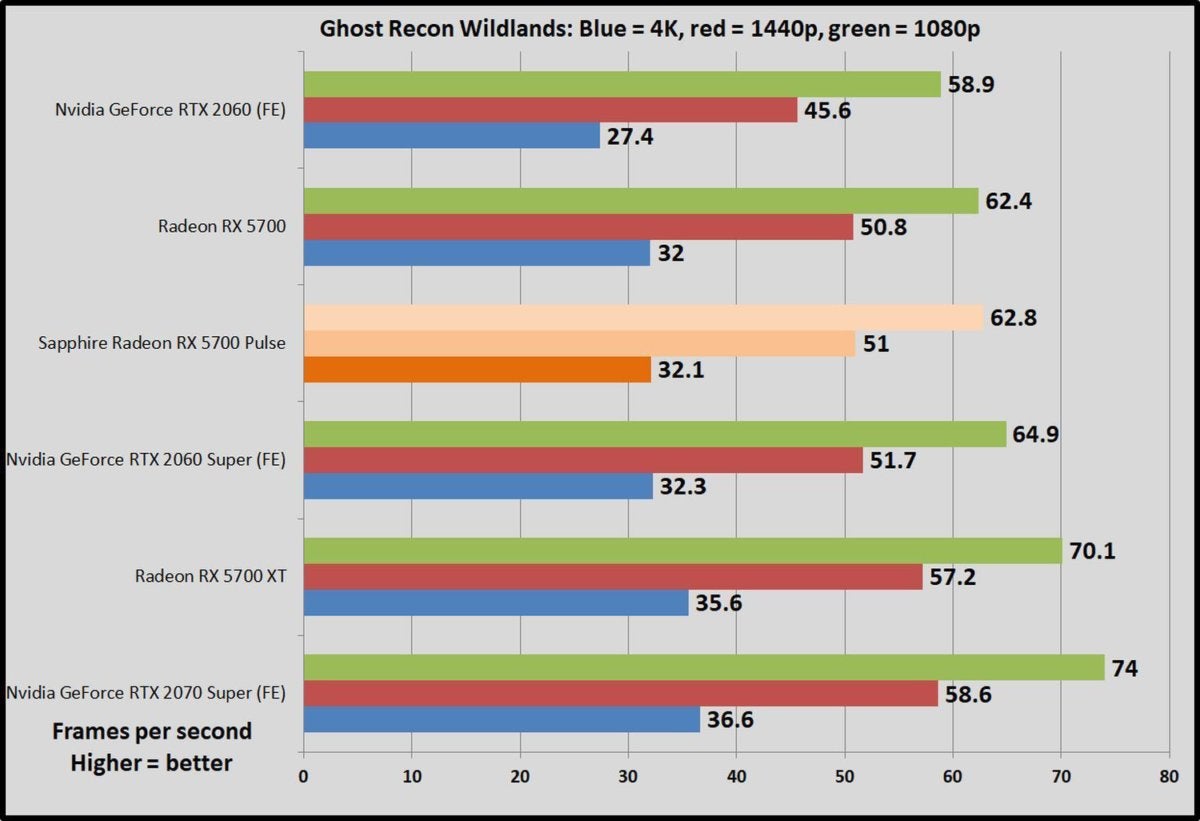 Brad Chacos/IDG
Brad Chacos/IDG F1 2018
The latest in a longstanding line of successful games,F1 2018($60 happening Humble) is a gem to test, supplying a wide of the mark array of both graphical and benchmarking options—making it a much more reliable (and fun) option that theForzaseries. IT's made-up on the ordinal adaptation of Codemasters' buttery-smooth Ego game railway locomotive. We test two laps happening the Australia course, with clear skies.
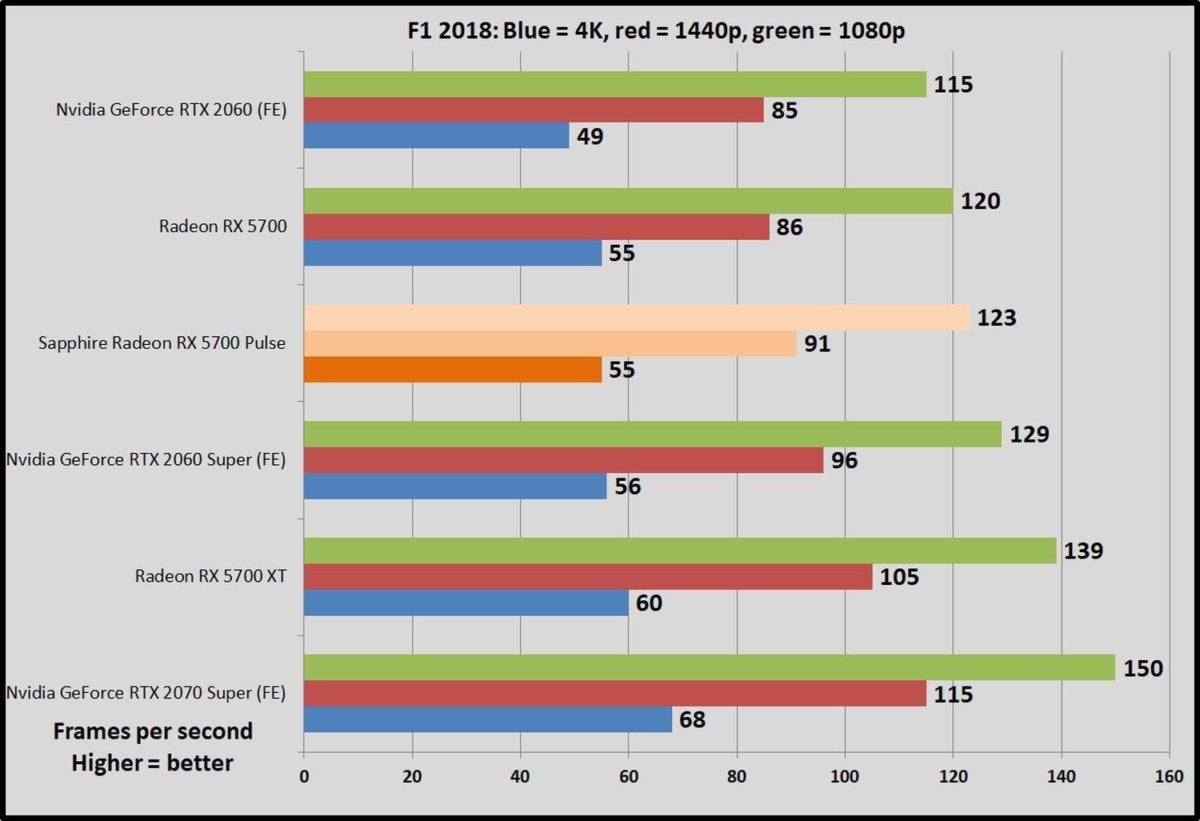 Brad Chacos/IDG
Brad Chacos/IDG GTA V
We're loss to wrap things up with a game that isn't truly a visual barn-burner, but still tops the Steam charts day in and day dead. We testGrand larceny Auto V ($30 on Humble) with entirely options turned to Precise High, all Advanced Graphics options except extended shadows enabled, and FXAA.GTA Vruns happening the Craze engine and has received sound updates since its initial launch.
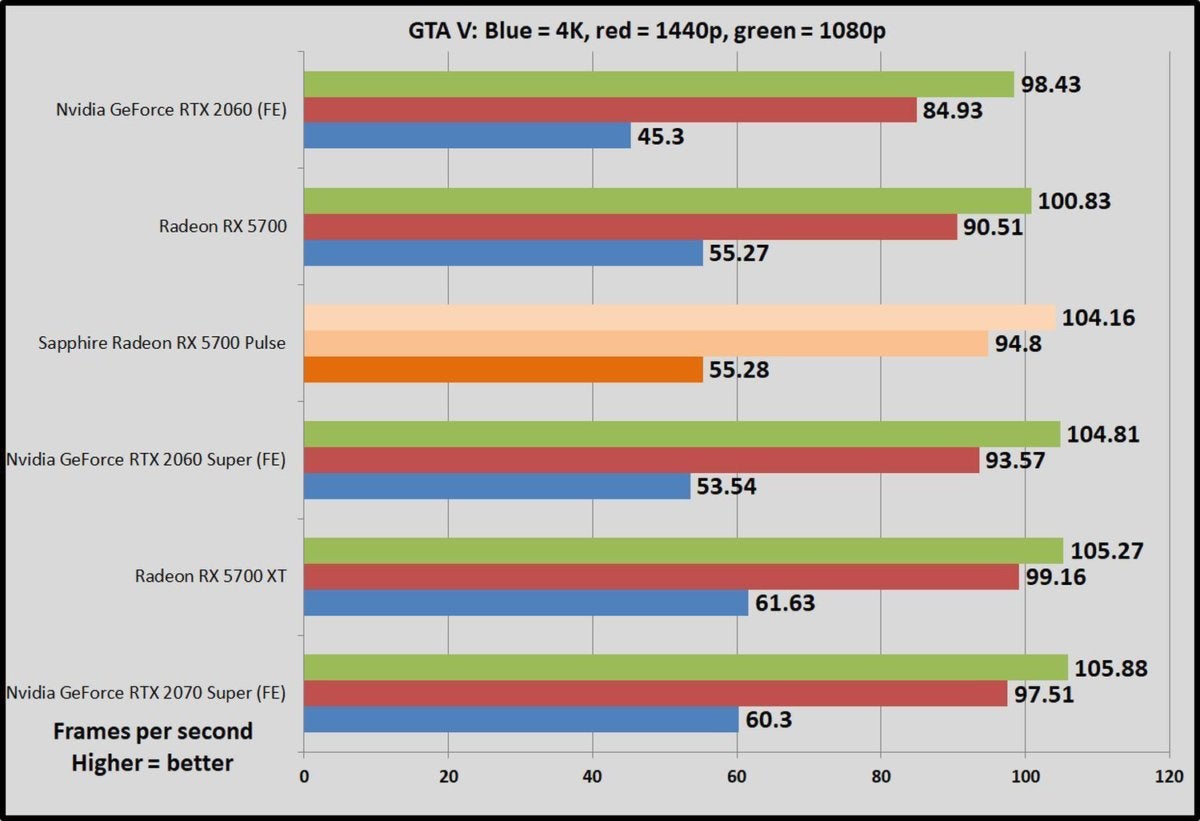 Brad Chacos/IDG
Brad Chacos/IDG Next paginate: Trixx Boost tested
Trixx Boost: Slightly take down solvent, much faster performance
Sapphire's releasing an updated version of its Trixx overclocking and monitoring software package to accompany their new generation of Radeon graphics card game, revolving around an awesome new feature dubbed "Trixx Boost." The recent version of Trixx ISN't expected to be for sale until rude September, as Sapphire's putting the finishing touches happening information technology, but the nub Boost functionality was provided to reviewers for examination.
I know information technology.
Trixx Supercharge essentially creates new exhibit resolutions that you can select in-lame, slimly less pixel-packed than the most common gaming resolutions: 4K, 1440p, and 1080p. The slender sink in total resolution greatly enhances gaming frame rates. Sapphire's tool allows you to activate AMD's superb new Radeon Image Sharpening technology to rejuvenate what little visual fidelity is lost at near no performance impact. The net image is near indistinguishable from version at native solution, but it runs at higher speeds.
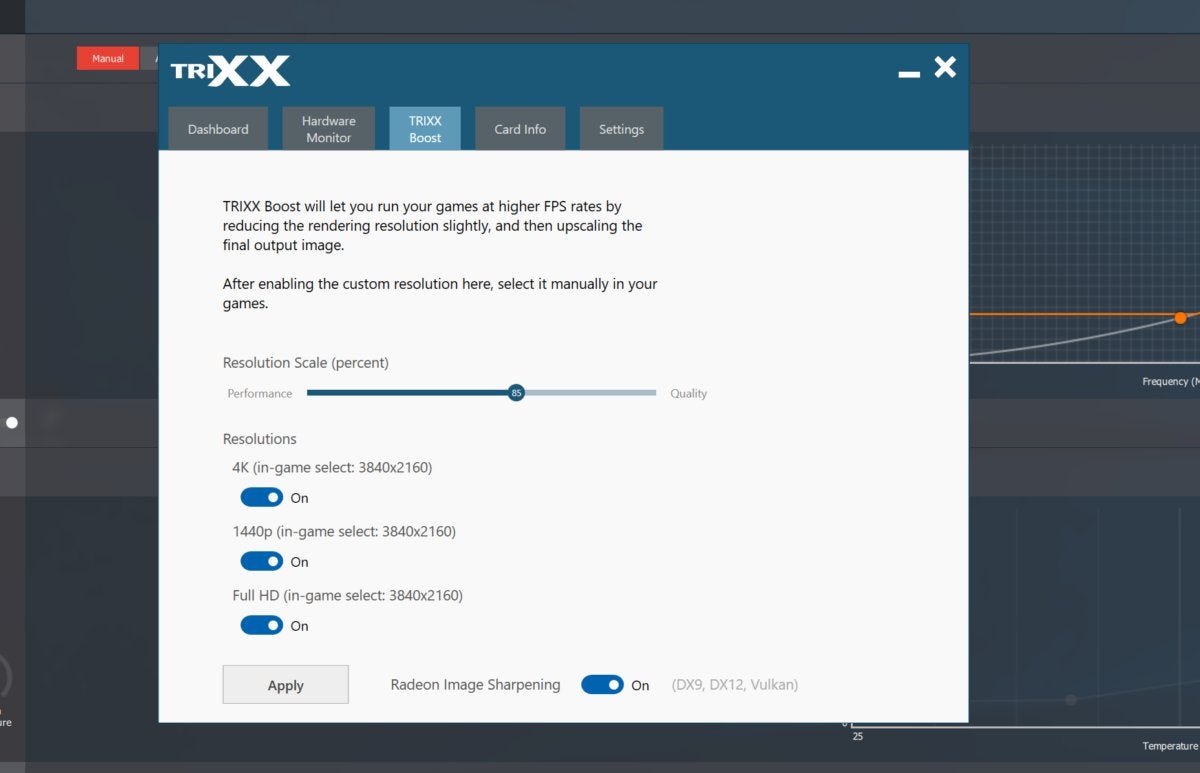 Brad Chacos/IDG
Brad Chacos/IDG Screenshot of an early prototype version of Lazuline's Trixx Hike up functionality.
Sapphire says Trixx Boost should work with older GPUs as healthy, though only if the Radeon RX 5700 series currently supports Radeon Image Sharpening. RIS too only works in DX9, DX12, and Vulkan games—crucially, DX11 (a.k.a. the nearly commonly used game renderer) isn't supported heretofore. Testing Trixx Boost in Far Cry: New Dawn, a DX11 game, shows adjacent to nary visual impact. Boost is the real wizard here; RIS is just the cherry on top when it's available.
Entering the Boost tab of Trixx reveals the puppet's straightforward settings. You use a Pseudemys scripta to determine at what percentage of the original resolving power you want the Boost resolutions created. By default, it was set to 85 pct, which I used for testing. You then make up one's mind which common gaming resolutions you need Boost variants for—you could create just one for your most-used resolution or enable the whole 4K/1440p/1080p stack—and choose whether to enable Radeon Paradigm Sharpening. Once you'Ra done, click Apply. Your screen will flash and glint for few seconds while the Pulse GPU creates the new resolutions.
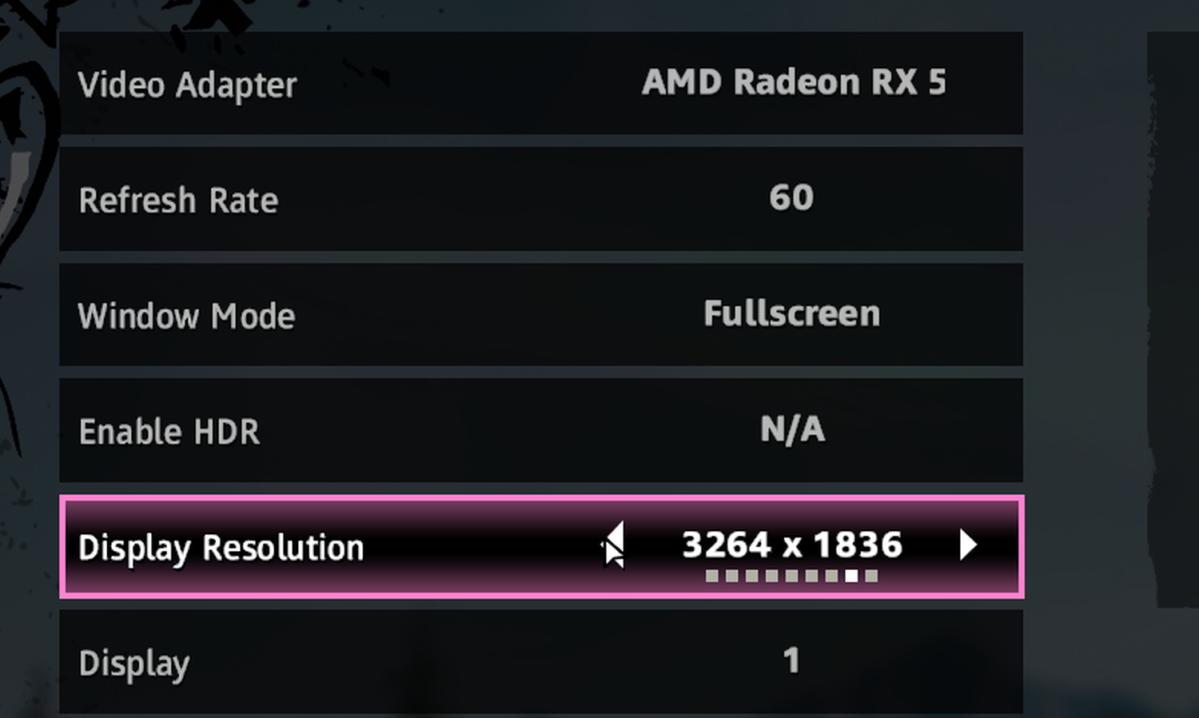 Brad Chacos/IDG
Brad Chacos/IDG Screenshot ofFar Cry: New Dawn screening a custom resolution created using Sapphire's Trixx Boost software.
All that's left to do after that is to select the new Further resolution manually in your games. As you can check in the image in a higher place, with Trixx Boost to 85 percent, it created a show resolution of 3264×1836 to exercise American Samoa an alternative to the standard 3840×2160 "4K" resolution. Some the standard resolutions as well As the Boost resolutions come along American Samoa options, indeed be sure to select the correct one to arrive Rise's advantages.
What an advantage it is. Here are the performance results running the following games at 1440p (the Radeon RX 5700's sweet spot) at touchstone 1440p resolution; at the Boost-created 2304×1296 resolution; and finally, at the Rise-created settlement with a soft overclock quickly created by AMD's Radeon Wattman creature applied, to show what's possible with under five minutes of menu tinkering. The kernel clock was boosted to 1,830MHz, and the memory time to 930MHz.
Just look at these results!
 Brad Chacos/IDG
Brad Chacos/IDG 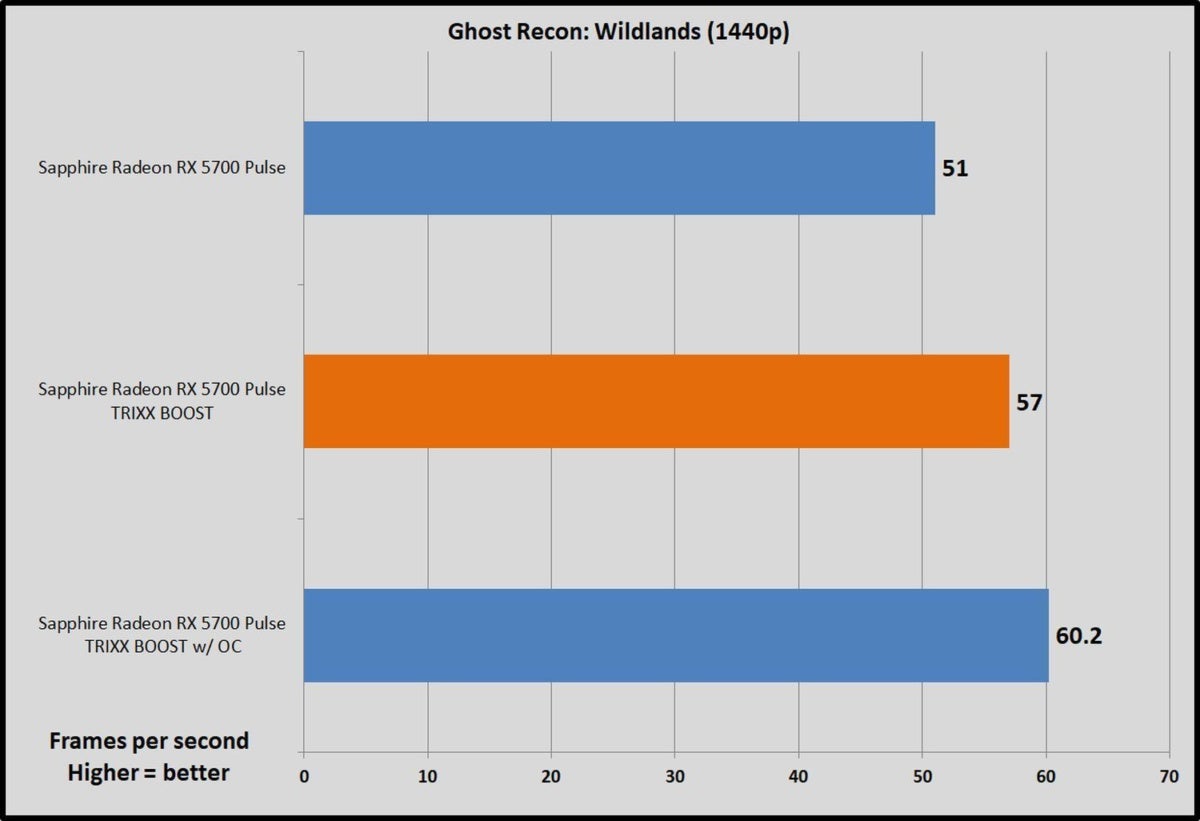 Brad Chacos/IDG
Brad Chacos/IDG  Brad Chacos/IDG
Brad Chacos/IDG For comparing, Nvidia's $350 GeForce RTX 2060 Founders Edition hit 45.6 frames per second in Ghost Recon: Wildlands at 1440p; 78 fps in Utmost Call out; and 55 Federal Protective Service in Section 2. The Sapphire Pulse RX 5700 far exceeds those speeds with Trixx Boost enabled, especially after the intelligent and dirty auto-overclock. With Boost and the overclock in target, these results actually competitor those of the $500 GeForce RTX 2070 Super, and pushesRight Cry into a Processor bottleneck. Hot bedamn. Plus, because Trixx Boost renders games at a slightly lower resolution than standard, IT doesn't result in increased energy draw or high temperatures. (That's manifestly not lawful if you overclock the GPU as well.)
These tricks aren't unique, to embody clear. You can create custom resolutions for the Lapp essence using another software system options. But few hoi polloi outside of enthusiasts ever bother with those more hardcore tools. Trixx Boost makes information technology so quick, easy, and harmless to attain noticeably faster speeds with minimal visual impact, it's a joy. This is a deep feathering in Sapphire's cap.
That's non to allege Trixx Boost is perfect. I'd same to encounter widescreen resolution options involute in as well, and for Sapphire to integrate Radeon Wattman's one-click car-overclocking into Trixx as well for a noob-friendly performance boost. (The software program supports overclocking, but only in extremity pattern, which requires more trial-and-error and time.) But this is a celestial body opening move, a chic spin on the industry's new infatuation with upscaling for more carrying out. I suspect other GPU makers may find "inhalation" from Trixx Boost soon.
Next Page: Power, thermals, and synthetics
Power draw, thermals, and synthetics
We besides tested the Sky-blue Pulse RX 5700 victimization 3DMark's highly respected Fire Strike artificial benchmark. Fire Strike runs at 1080p, Fire Strike Extreme runs at 1440p, and Fire Strike Ultra runs at 4K resolution. Totally render the same scene, but with to a greater extent intense graphical effects as you uprise the scale, and so that Extreme point and Ultra flavors stress GPUs even more. We record the graphics tally to eliminate variance from the Central processor.
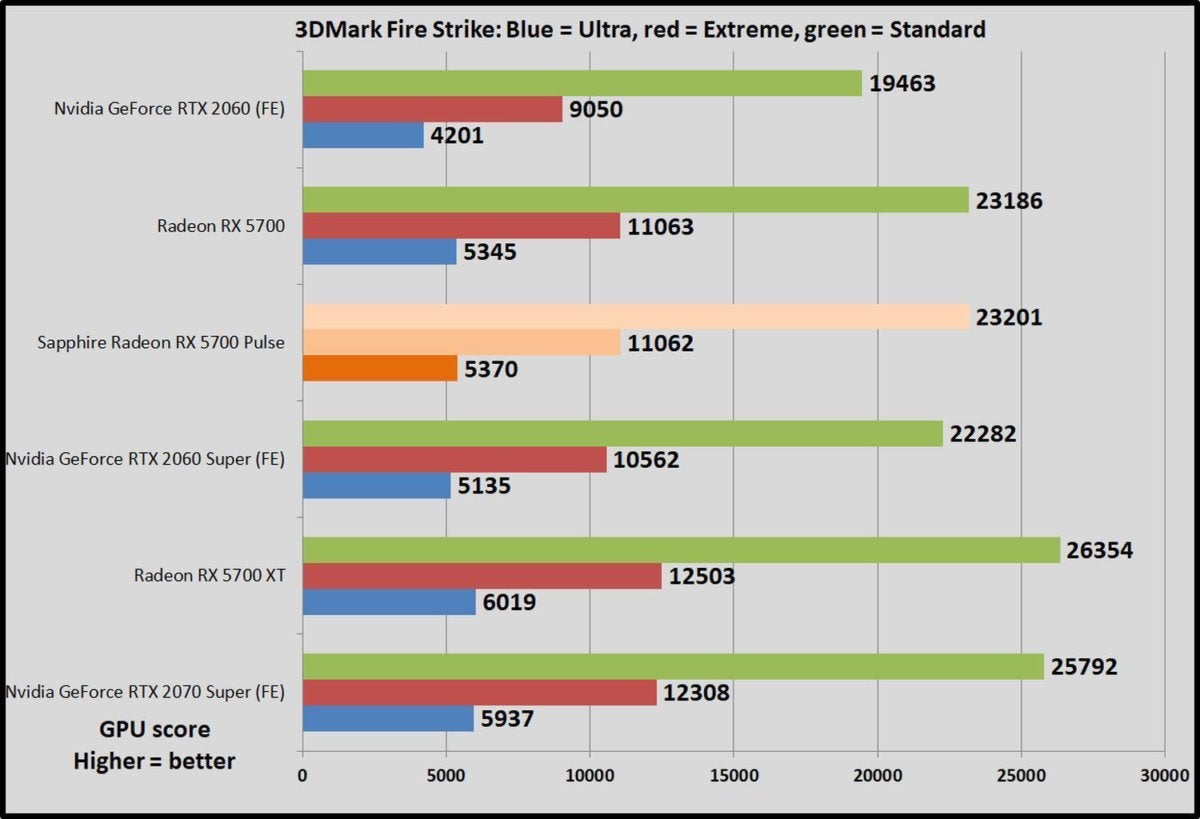 Brad Chacos/IDG
Brad Chacos/IDG We test thermals by leaving either AMD's Wattman (for Radeon GPUs) or EVGA's Preciseness X1 (for GeForce GPUs) active during theF1 2018 five-lap king draw examine, noting the highest maximum temperature at the close.
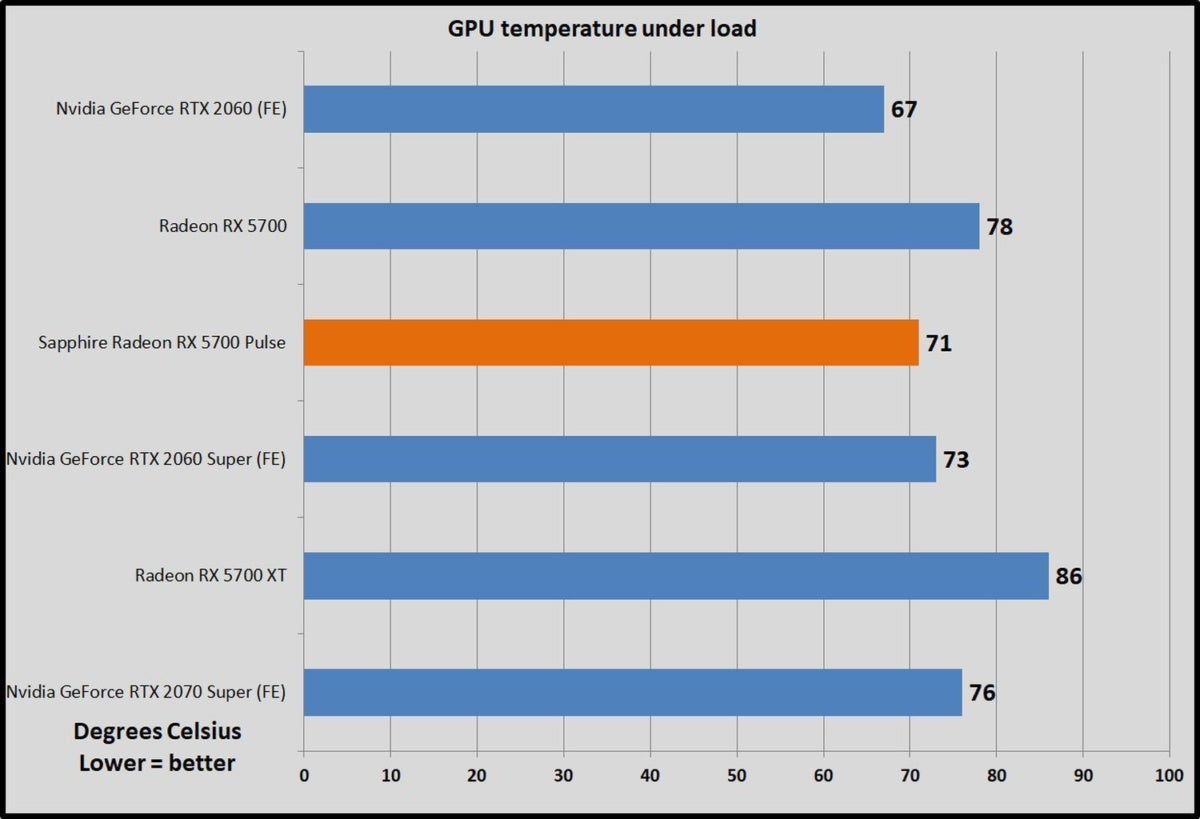 Brad Chacos/IDG
Brad Chacos/IDG We run mightiness draw by looping theF1 2018 bench mark for about 20 minutes after we've benchmarked everything else, and noting the highest Reading on our Watts Up Pro m. The initial start of the race, where all competing cars are onscreen simultaneously, tends to be the most demanding portion.
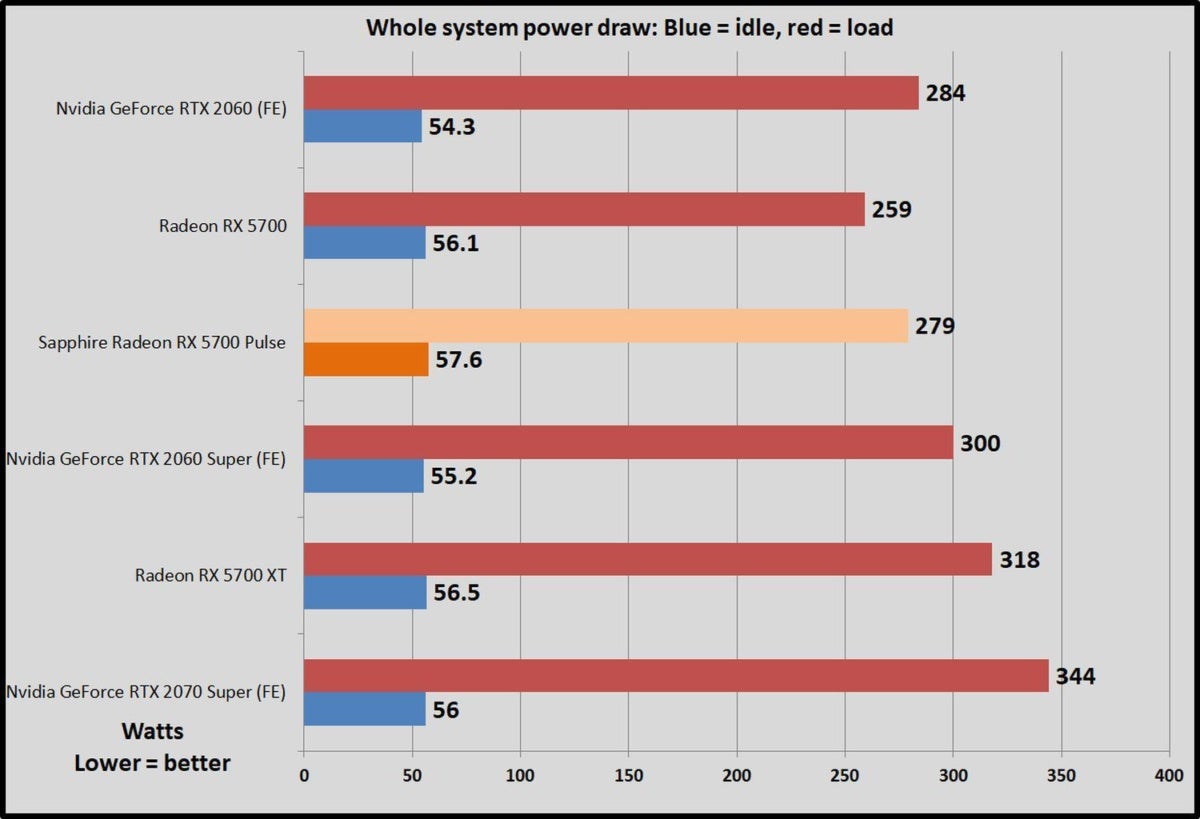 Brad Chacos/IDG
Brad Chacos/IDG No surprises here. The slightly overclocked Sapphire Pulse draws slightly more king than the reference Radeon RX 5700, while its dual-axial cooler provides practically major temperature reduction. IT's also significantly quieter eve in Performance mode. Dandy for an excess ennead dollars! And piece we covered this in more detail in our original Radeon RX 5700 follow-up, it's worth highlighting again that AMD's new RDNA architecture on the 7nm manufacturing process has managed to pull ahead of Nvidia's vaunted power efficiency, delivering more performance at less peak power.
Next Thomas Nelson Page: Should you buy the Chromatic Pulse RX 5700?
Should you purchase the Cerulean Pulse RX 5700?
Yes. Definitely.
The reference Radeon RX 5700 earned 4.5 stars, our Editors' Choice honour, and our recommendation as the first 1440p graphics card for most people on the back of its GeForce RTX 2060-beating carrying out and stellar value. The Sapphire Pulse Radeon RX 5700 is only slightly faster than the reference card in unsuccessful-of-the-box performance, but the greatly enhanced cooler, dual-BIOS flip-flop, metal backplate, and strong internal components easily justify the card's itty-bitty $9 markup. Club. Dollars.
There's no reason to purchase a Radeon RX 5700 reference intent any longer unless you need the electric fan-style fan for a fine form factor system, full end.
 Brad Chacos/IDG
Brad Chacos/IDG The $359 Sapphire Heart rate RX 5700 is faster than the similarly priced GeForce RTX 2060. Once the caller releases its Trixx software upgrade with the new Trixx Boost feature in early September, IT should come within spitting space of the $500 GeForce RTX 2070 Superior's performance by pairing a slight, practically unnoticeable resolution downgrade with AMD's superb Radeon Visualize Sharpening technology. It's a shame Trixx Boost won't equal ready when Azure's graphics card hits the streets now, just if you buy this graphics card, hop on it the moment it becomes available.
Sapphire deserves major props for seizing advantage of the current upscaling cu so in effect—and for making information technology so simplified for gamers to rap into the significant potential performance advantages.
In that location's no reason to purchase the $350 GeForce RTX 2060 over the Sapphire Pulse RX 5700, unless you chance to find one along sales event for well under $300 (which buttocks occasionally bump). The only reason to prefer for a $400 GeForce RTX 2060 Tops over Sapphire's card is if you want to invest in real-time ray trace, atomic number 3 Nvidia GPUs alone contain hardware devoted to fast those tasks. The technology's only available in a handful of games at the consequence, though it's coming to several topmost-tier up games (same Cyberpunk 2077 and Doom Endless) all over the incoming twelvemonth.
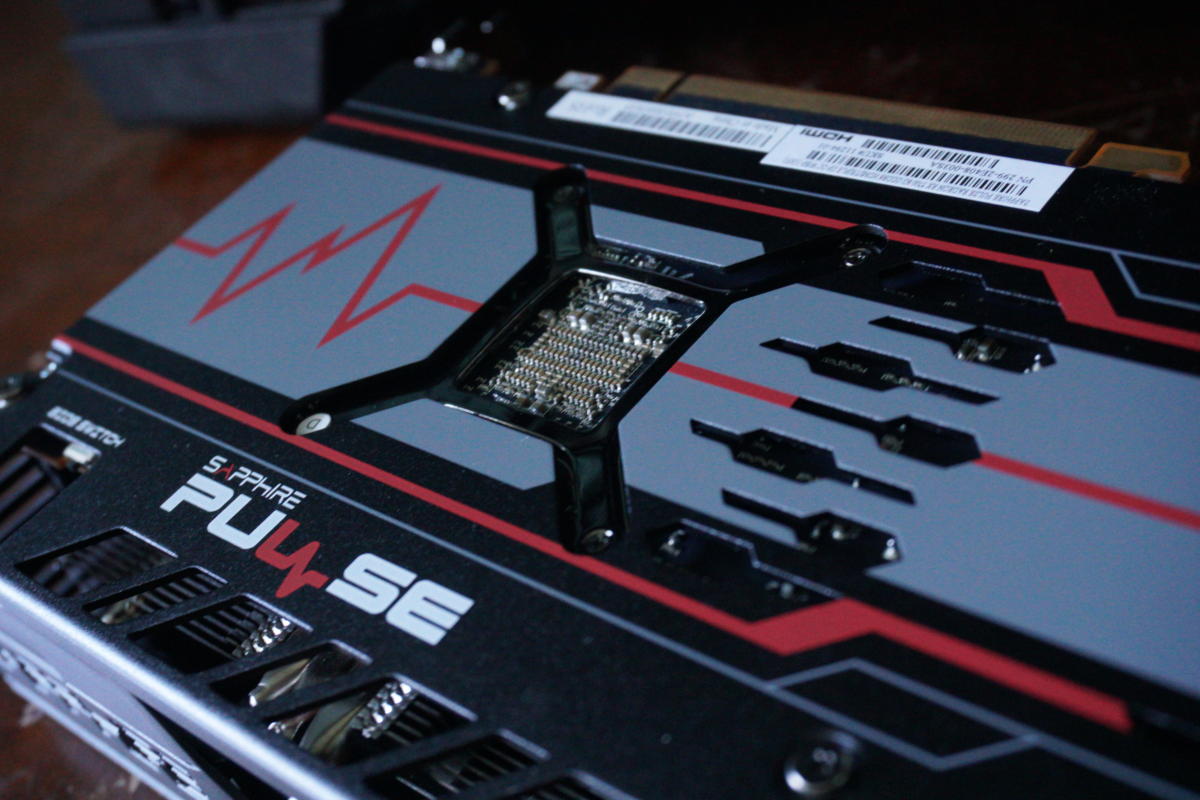 Brad Chacos/IDG
Brad Chacos/IDG AMD knocked information technology out of the park with the Radeon RX 5700. Sapphire's budget-friendly spin out on it is also a home base run, offer several extra features and niceties Eastern Samoa well Eastern Samoa a much-improved cooling answer for upright $9 more. (Nine! Dollars!) Thomas More feature-packed custom Radeons are no doubt on the way, simply the Sapphire Pulse RX 5700 nails the basics, moves the finish posts forward with Trixx Boost, and well earns our Editors' Superior award on the back of its outstanding measure proposition.
Highly, extremely advisable.
Note: When you purchase something after clicking links in our articles, we may earn a littler commission. Read our consort link policy for more details.
Source: https://www.pcworld.com/article/397887/sapphire-pulse-rx-5700-review.html
Posted by: mccrayfourgaver99.blogspot.com


0 Response to "Sapphire Pulse Radeon RX 5700 review: A stunning value supercharged by clever software tricks - mccrayfourgaver99"
Post a Comment